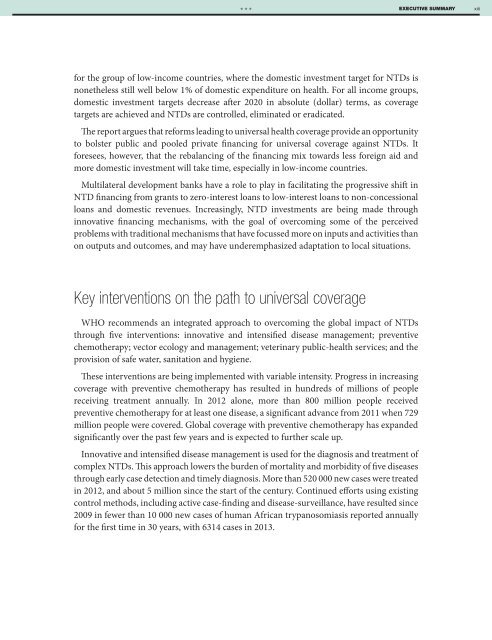1A9bnbK
1A9bnbK
1A9bnbK
Create successful ePaper yourself
Turn your PDF publications into a flip-book with our unique Google optimized e-Paper software.
***<br />
EXECUTIVE SUMMARY<br />
xiii<br />
for the group of low-income countries, where the domestic investment target for NTDs is<br />
nonetheless still well below 1% of domestic expenditure on health. For all income groups,<br />
domestic investment targets decrease after 2020 in absolute (dollar) terms, as coverage<br />
targets are achieved and NTDs are controlled, eliminated or eradicated.<br />
The report argues that reforms leading to universal health coverage provide an opportunity<br />
to bolster public and pooled private financing for universal coverage against NTDs. It<br />
foresees, however, that the rebalancing of the financing mix towards less foreign aid and<br />
more domestic investment will take time, especially in low-income countries.<br />
Multilateral development banks have a role to play in facilitating the progressive shift in<br />
NTD financing from grants to zero-interest loans to low-interest loans to non-concessional<br />
loans and domestic revenues. Increasingly, NTD investments are being made through<br />
innovative financing mechanisms, with the goal of overcoming some of the perceived<br />
problems with traditional mechanisms that have focussed more on inputs and activities than<br />
on outputs and outcomes, and may have underemphasized adaptation to local situations.<br />
Key interventions on the path to universal coverage<br />
WHO recommends an integrated approach to overcoming the global impact of NTDs<br />
through five interventions: innovative and intensified disease management; preventive<br />
chemotherapy; vector ecology and management; veterinary public-health services; and the<br />
provision of safe water, sanitation and hygiene.<br />
These interventions are being implemented with variable intensity. Progress in increasing<br />
coverage with preventive chemotherapy has resulted in hundreds of millions of people<br />
receiving treatment annually. In 2012 alone, more than 800 million people received<br />
preventive chemotherapy for at least one disease, a significant advance from 2011 when 729<br />
million people were covered. Global coverage with preventive chemotherapy has expanded<br />
significantly over the past few years and is expected to further scale up.<br />
Innovative and intensified disease management is used for the diagnosis and treatment of<br />
complex NTDs. This approach lowers the burden of mortality and morbidity of five diseases<br />
through early case detection and timely diagnosis. More than 520 000 new cases were treated<br />
in 2012, and about 5 million since the start of the century. Continued efforts using existing<br />
control methods, including active case-finding and disease-surveillance, have resulted since<br />
2009 in fewer than 10 000 new cases of human African trypanosomiasis reported annually<br />
for the first time in 30 years, with 6314 cases in 2013.


